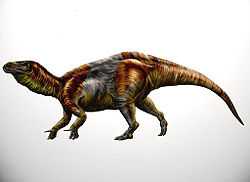Delapparentia
| Delapparentia Temporal range: 130–127Ma | |
|---|---|
 | |
| Restoration | |
| Scientific classification | |
| Kingdom: | Animalia |
| Phylum: | Chordata |
| Clade: | Dinosauria |
| Order: | †Ornithischia |
| Clade: | †Ornithopoda |
| Clade: | †Hadrosauriformes |
| Genus: | †Delapparentia Ruiz-Omeñaca, 2011 |
| Species | |
Delapparentia is a genus of iguanodont dinosaur from the Early Cretaceous period of Galve, Teruel Province, Spain.[1]
The type specimen, MPT/I.G, was found in the Spring of 1958 by amateur palaeontologist José María Herrero Marzo. From 25 September 1958 it was collected by Professor Dimas Femández-Galiano, assisted by a Dutch team from the University of Utrecht led by Gustav Heinrich Ralph von Koenigswald. The finds were originally assigned to Iguanodon bernissartensis by Albert-Félix de Lapparent in 1960.[2] In 2006 José Ignacio Ruiz-Omeñaca named it Delapparentia turolensis in a dissertation.[3] Such a nomen ex dissertatione being invalid, he validly named it in 2011. The generic name honours de Lapparent. The specific name is derived from the Latin name of Teruel, Turia.[1]
The holotype was discovered and collected from La Maca 3 locality in the Camarillas Formation of Galve dating to the early Barremian stage (about 130-127 million years ago). The holotype is a partial skeleton lacking the skull, of an adult individual. It consists of four cervical vertebrae, twenty-eight neurapophyses, two sacral vertebrae, fourteen caudal vertebrae, fragments of cervical, dorsal and sternal ribs, fragments of five chevrons, numerous ossified tendons and a left pubis and ilium. Some other bones, misidentified by de Lapparent as those of the sauropod Aragosaurus, were referred to Delapparentia, among them an ischium. Several autapomorphies (unique characteristics) of Delapparentia were established: posterior dorsal ribs with long, parallel and unfused capitula and tubercula, ossified sternal ribs, and a straight and lateromedially expanded preacetabular process of the ilium. It also presents a unique combination of anterior dorsal ribs with a pneumatic foramen and an ischium that is large in relation to the ilium.[1]
Delapparentia was a large species, about 15% longer than Iguanodon bernissartensis. The length has been estimated at ten metres, the weight at 3.5 tonnes. The ilium is 78 centimetres long.[1]
Delapparentia was by Ruiz-Omeñaca assigned to the Iguanodontoidea in 2011.[1]
References
- ↑ 1.0 1.1 1.2 1.3 1.4 José Ignacio Ruiz-Omeñaca (2011). "Delapparentia turolensis nov. gen et sp., un nuevo dinosaurio iguanodontoideo (Ornithischia: Ornithopoda) en el Cretácico Inferior de Galve [Delapparentia turolensis nov. gen et sp., a new iguanodontoid dinosaur (Ornithischia: Ornithopoda) from the Lower Cretaceous of Galve (Spain)]". Estudios Geológicos 67 (1): 83–110. doi:10.3989/egeol.40276.124.
- ↑ Albert-Félix de Lapparent (1960). "Los dos dinosaurios de Galve". Teruel 24: 177–197.
- ↑ José Ignacio Ruiz-Omeñaca (2006). "Restos directos de dinosaurios (Saurischia, Ornithischia) en el Barremiense (Cretácico Inferior) de la Cordillera Ibérica en Aragón (Teruel, España)". Tesis doctoral, Universidad de Zaragoza, Zaragoza: xii + 439 pp.